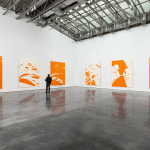
Contributed by Jason Andrew / In an exhibition of ten new paintings at the Carnegie Museum in Pittsburgh, Ruth Root extends her definition of the medium and her own personal language. Since the late 1990s, through a variety of “painting” materials, Root has charted an independent course through a Formalist-sanctioned medium, often rigidly classified by shape, color, and space. She is among the best pictorial pathfinders working today.
A self-proclaimed appreciator of both historical and contemporary painting, Root�s work lives in a poem-ic space reminiscent of Cubism’s architecture and Minimalism’s polemical landscape. �The paintings are almost like flattened sculptures that I have turned into paintings,� Root explained in an interview in 2015 during the occasion of her survey at the Aldrich Museum.

The new batch of paintings, all untitled and dated 2019, features a broadly explored theme of inversion and contrast. For example, two paintings are identically shaped and mirror each other. Even though this compositional strategy seems simple, Root has is able to distinguish the paintings with mark and color so that the phrasing of each is completely unique�variations on a theme of variations.

Clear rules, principles, and processes govern the making of these works. For instance, the “edge” and its relationship to the wall is critical to a understanding them. Curved versus hard-angled corners play off the interior loop-linking of one element to the next. Structurally, Root’s system builds from bottom to top in various levels of construction and complexity. In expansive planes that feature wide, sharply painted blocks, solid shapes and stripes anchor organic marks of sprayed on dots and hand-pulled lines. Root appears aware that by juxtaposing strongly clashing tones she can produce an immediate, violent sensation. Yet overall, her touch is gentle.

Each work is capped with a fabric panel printed with repeating images photoshopped into place in patterns that read like hieroglyphs. These logographic timestamp the work with cut-and-pasted imagery from current events. Some reproduce artworks or design objects selected from the vast collection of the Carnegie Museum: a Baer, a Benglis, a Bontecou. There�s a game in deciphering the precise meaning of all these adjoining glyphs. She borrows only the eyes from paintings by Alex Katz in one piece, from Kerry James Marshall in another. Christine Blasey Ford taking the oath surfaces in a painting, and the headshot of Supreme Court Justice Ruth Bader Ginsburg appears in two more. �I think making connections between everyday things, and art things, and things happening in the work is essential for painting and for looking at paintings,� Root explained in an interview earlier this year.


There�s a painting in which Root leaves the surface bare of any marks or gestures. Only the structure is visible. You�ve got to know how to discard, as a gambler might say; selection is key to great technique. This work strikes a tone of strength and vulnerability, resonant with potentials, possibilities, and risk.

I daresay Root has found her stride, having embraced the vibe of the handmade buttressed by the manufactured. Great care is taken in connecting each element within a work, and each seems to be of equal value. The sensuality of the stitch and the grommets Root uses to hang the work have the same gravitas. These are the subtle details that lend Root’s work a contemporary subtext, referencing craft and gender politics (which the artist doesn�t refute). All this says a great deal about Root�s independence from traditional painting and her importance in art today. The precise meaning that she incorporates into her handsome paintings provides a kind of syntax for a world that often seems desperately ungrammatical.
“Forum 81: Ruth Root,” curated by Eric Crosby, Henry J. Jeinz II Acting Co-Driector and Richard Armstrong Senior Curator of Modern & Contemporary Art, Carnegie Museum of Art. Carnegie Museum of Art, 4400 Forbes Avenue, Pittsburgh, PA . Through August 25, 2019.
About the author: Jason Andrew is an independent scholar, curator, and producer who co-founded and directs Norte Maar, a non-profit organization that creates, promotes, and presents collaborative projects in the arts. He can be followed on Twitter, @jandrewARTS.
Related posts:
Ruth Root�s deep integration
Thomas Nozkowski has died
Legacy of the hand: Paolo Arao�s textile paintings
Bj�rn Meyer-Ebrecht: Spontaneity rising























Thanks for this post,great work and a good read of analysis,pithy,and appropriate as one accustomed to a curious fascination with the use of formal values in painting.